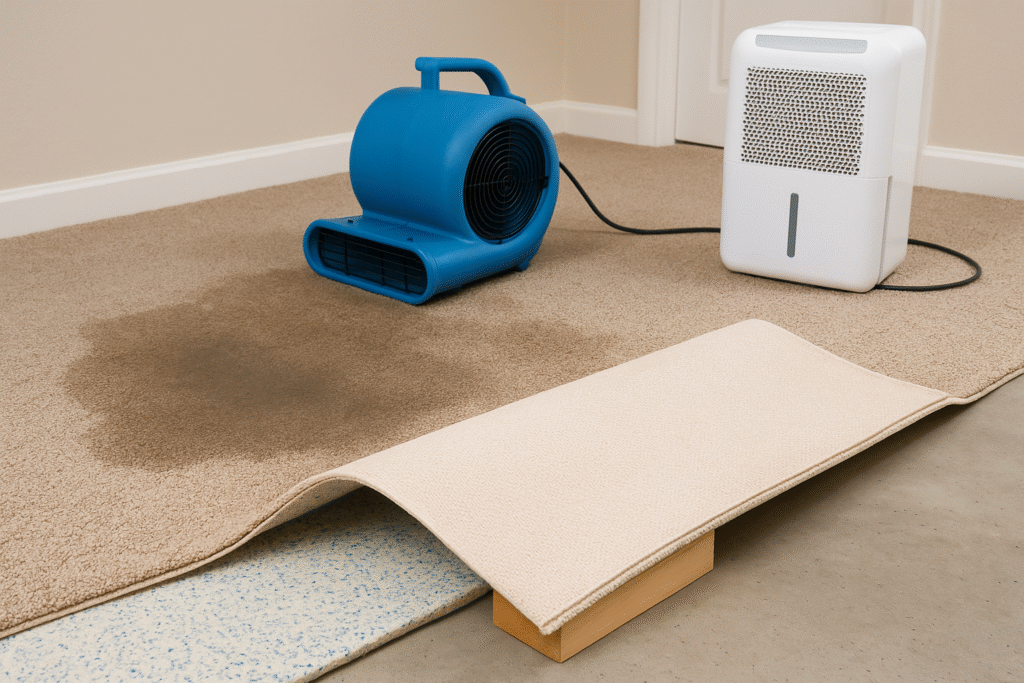Wet carpet is one of the most common issues homeowners face after leaks, flooding, or storm damage. Left untreated, it can quickly lead to mould growth, odours, and permanent damage to your flooring and subfloor. While professional wet carpet drying is the safest and most effective option, there are steps you can take yourself to minimise the damage before calling in the experts.
Step 1: Act Fast
Time is critical. Carpets can begin to grow mould within 24–48 hours. As soon as you notice wet carpet, start the drying process immediately.
Step 2: Remove Excess Water
-
Use towels, mops, or a wet/dry vacuum to extract as much water as possible.
-
Avoid pressing too hard, which may push water deeper into the underlay.
Step 3: Lift and Check the Underlay
The underlay beneath your carpet acts like a sponge — once soaked, it holds water and can cause mould, odours, and long-term damage if not handled properly. You have a few options depending on the extent of the damage:
-
Remove & Dry Outside – If the underlay is only lightly affected, carefully remove it and place it outside to dry. Once it’s completely dry — and the subfloor is also dry — it can usually be relaid.
-
Dry Subfloor & Reuse – If both the underlay and subfloor are wet, remove the underlay, thoroughly dry the subfloor with fans or dehumidifiers, then dry the underlay separately before relaying it.
-
Replace with New Underlay – If the underlay has been heavily soaked, smells musty, or shows signs of mould, it’s safer to dispose of it and install new underlay after the subfloor has been dried.
?? Important: The subfloor underneath must be completely dried. If moisture is left behind, it will continue to evaporate back into the carpet, causing ongoing dampness, odours, and mould growth.
Step 4: Increase Airflow and Use Dehumidifiers
-
Raise the carpet by placing blocks, foil, or other spacers between the carpet and subfloor. This allows air to circulate underneath and speeds up drying.
-
Open windows and doors to create cross-ventilation when using fans.
-
If you’re using a dehumidifier, close windows and doors to concentrate the drying power inside the room.
-
Run the dehumidifier continuously until the carpet, underlay, and subfloor are completely dry. If you don’t own one, you can hire a professional-grade unit from suppliers like Restoration Warehouse, which will dry carpets and underlays far more effectively than small home models.
Step 5: Check Walls and Surrounding Materials
If water has touched the plasterboard wall, there’s a risk it has soaked through to the insulation inside. This is a serious concern — if the wall cavity is not dried properly, mould can begin to form within a few weeks, hidden behind the wall. Carefully check for signs of dampness on skirting boards, plaster, and insulation, and consider professional drying if water has penetrated these areas.
Step 6: Clean and Disinfect
-
Apply an antimicrobial carpet cleaner or household disinfectant to prevent mould growth.
-
Always test a small patch first to ensure the cleaner won’t damage your carpet fibres.
Step 7: Monitor for Mould and Odours
-
Keep checking for musty smells, visible mould, or lingering dampness.
-
If carpets remain wet after 48 hours, professional intervention is strongly advised.
When to Call the Professionals
DIY carpet drying can work for small spills or light leaks, but if your carpet has been soaked by flooding, sewage, stormwater, or if walls and insulation are affected, it requires specialist treatment. Professional restoration teams like Reztor Restoration use advanced water extraction equipment, industrial dehumidifiers, and thermal imaging to ensure carpets, underlay, subfloors, and wall cavities are completely dry and safe.
Final Thoughts
Trying to dry wet carpet yourself is a useful first step, but don’t take risks with your property or health. Fast action can save your flooring, but if in doubt, contact a certified restoration company to properly assess and restore the damage.
? If you’re dealing with a water emergency, Reztor Restoration offers 24/7 wet carpet drying and water damage services across Brisbane and Australia.



